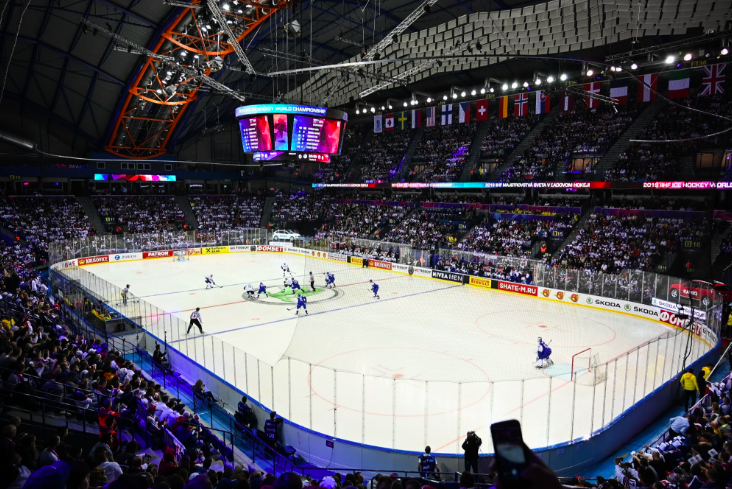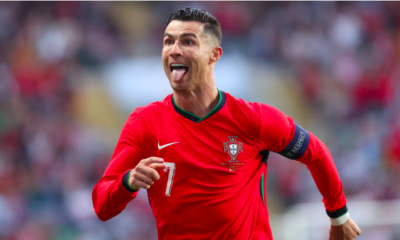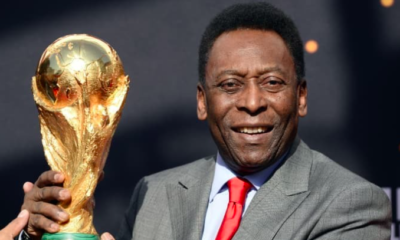Hockey
The Thrilling World of Ice Hockey: A Deep Dive into the Sport

The Thrilling World of Ice Hockey: A Deep Dive into the Sport
Ice hockey, a fast-paced and thrilling sport, has captured the hearts of millions worldwide. Known for its intense action, strategic plays, and passionate fans, ice hockey offers a unique blend of athleticism and excitement. In this article, we explore the origins of the sport, its rules, key players, and its impact on popular culture.
History of Ice Hockey
Origins and Early Development
Ice hockey traces its roots back to the frozen ponds and lakes of Canada in the 19th century. It is widely believed that the sport evolved from stick-and-ball games brought to North America by European settlers. The first organized game of ice hockey took place in Montreal in 1875, laying the foundation for what would become a global phenomenon.
Evolution of the Rules
The early versions of ice hockey were chaotic and unstructured. As the sport grew in popularity, standardized rules were developed. The first set of formalized rules was codified by the Montreal Hockey Club in 1877. These rules established the basic structure of the game, including the number of players, the dimensions of the rink, and the use of a puck instead of a ball.
The Basics of Ice Hockey

Objective and Gameplay
The primary objective of ice hockey is to score more goals than the opposing team. Each team consists of six players: three forwards, two defensemen, and one goaltender. The game is played on an ice rink divided into three zones: the defensive zone, the neutral zone, and the offensive zone.
Equipment and Gear
Ice hockey players wear a variety of protective gear to prevent injuries. This includes helmets, shoulder pads, elbow pads, gloves, shin guards, and skates. The goaltender, or goalie, wears additional padding and a specialized mask to protect against high-speed shots.
Rules and Regulations
The game of ice hockey is governed by a set of rules designed to ensure fair play and safety. Some key rules include offsides, icing, and penalties for infractions such as tripping, hooking, and high-sticking. Understanding these rules is essential for both players and fans to fully appreciate the game.
Key Strategies and Plays
Offensive Strategies
Successful offensive strategies in ice hockey often involve quick passes, precise positioning, and effective use of space. Common offensive plays include the power play, where a team has a numerical advantage due to a penalty on the opposing team, and the breakaway, where a player moves quickly toward the goal with no defenders in front.
Defensive Tactics
Defensive strategies are crucial for preventing the opposing team from scoring. Key tactics include zone defense, where players cover specific areas of the rink, and man-to-man defense, where each player is responsible for marking a specific opponent. Effective shot-blocking and goaltending are also vital components of a strong defense.
Notable Players in Ice Hockey History
Wayne Gretzky: The Great One
Wayne Gretzky, often referred to as “The Great One,” is widely considered the greatest hockey player of all time. Over his illustrious career, Gretzky set numerous records, including the most goals and points in NHL history. His vision, skill, and leadership on the ice have left an indelible mark on the sport.
Bobby Orr: Revolutionizing the Defenseman Role
Bobby Orr is renowned for transforming the role of the defenseman in ice hockey. Known for his exceptional skating ability and offensive prowess, Orr redefined what it meant to play defense. His influence is still felt today, as modern defensemen continue to emulate his style.
Mario Lemieux: Overcoming Adversity
Mario Lemieux’s career is a testament to resilience and perseverance. Despite battling serious health issues, including Hodgkin’s lymphoma, Lemieux achieved remarkable success on the ice. His skill and determination have made him a beloved figure in the hockey community.
The Global Impact of Ice Hockey
Growth of the NHL
The National Hockey League (NHL) is the premier professional ice hockey league in the world. Founded in 1917, the NHL has grown to include 32 teams across the United States and Canada. The league has played a significant role in popularizing the sport and bringing it to new audiences.
International Competitions
Ice hockey is a major sport in several countries, including Canada, the United States, Russia, Sweden, and Finland. International competitions such as the Winter Olympics and the IIHF World Championships showcase the best talent from around the globe and foster a sense of camaraderie among nations.
Development Programs and Youth Leagues
To sustain the growth of ice hockey, numerous development programs and youth leagues have been established worldwide. These programs aim to nurture young talent, provide coaching and training, and promote the sport at the grassroots level. The future of ice hockey looks bright, with a new generation of players ready to make their mark.
The Role of Technology in Modern Ice Hockey
Advancements in Equipment
Technological advancements have revolutionized ice hockey equipment, making it safer and more efficient. Modern helmets, pads, and skates are designed to provide maximum protection without compromising mobility. Innovations such as composite sticks and performance-enhancing gear have also improved player performance.
Data Analytics and Performance Tracking
Data analytics and performance tracking have become integral parts of modern ice hockey. Teams use advanced statistics and video analysis to evaluate player performance, develop strategies, and gain a competitive edge. Wearable technology and GPS tracking provide real-time data on player movements and conditioning.
Fan Engagement and Digital Platforms
The digital age has transformed how fans engage with ice hockey. Social media, streaming services, and interactive apps allow fans to stay connected with their favorite teams and players. Virtual reality (VR) and augmented reality (AR) experiences are also enhancing the way fans watch and interact with the game.
Ice Hockey and Popular Culture
Hockey in Film and Television
Ice hockey has been a popular theme in film and television, with numerous movies and shows celebrating the sport. Classics like “Slap Shot” and “The Mighty Ducks” have captured the essence of hockey culture and introduced the sport to new audiences. Documentaries like “The Russian Five” offer an in-depth look at significant moments in hockey history.
Music and Ice Hockey
Music and ice hockey often go hand in hand, with many teams having signature goal songs and anthems. The high-energy atmosphere of a hockey game is complemented by music that pumps up players and fans alike. Artists like Stompin’ Tom Connors have even written songs specifically about hockey.
Hockey Memorabilia and Collectibles
Hockey memorabilia and collectibles are cherished by fans and collectors. Items such as autographed jerseys, pucks, and trading cards hold significant value and offer a tangible connection to the sport’s history. Collecting hockey memorabilia is a popular hobby that keeps the spirit of the game alive.
The Future of Ice Hockey
Expanding the Reach of the Sport
The future of ice hockey lies in expanding its reach to new regions and demographics. Efforts to promote the sport in non-traditional hockey markets, such as Asia and the southern United States, are already underway. The NHL’s initiatives to host games and events in these areas are crucial for the sport’s global growth.
Sustainability and Environmental Initiatives
Ice hockey organizations are increasingly focusing on sustainability and environmental initiatives. From eco-friendly arenas to community outreach programs, the sport is committed to reducing its environmental impact. These efforts align with the broader goal of promoting a healthier planet for future generations.
Innovations in Training and Development
Continuous innovations in training and development will shape the future of ice hockey. Advances in sports science, nutrition, and coaching techniques will enhance player performance and reduce the risk of injuries. Embracing these innovations will ensure that ice hockey remains a dynamic and evolving sport.
Conclusion
Ice hockey is more than just a sport; it is a cultural phenomenon that brings people together. From its humble beginnings on frozen ponds to its status as a global spectacle, ice hockey has captivated audiences with its speed, skill, and excitement.
As the sport continues to grow and evolve, it will undoubtedly inspire new generations of players and fans. The future of ice hockey is bright, and we look forward to witnessing the next chapter in its storied history.
Frequently Asked Questions (FAQs)
What are the basic rules of ice hockey?
Ice hockey is played with two teams of six players each, aiming to score goals by shooting a puck into the opponent’s net. Key rules include offsides, icing, and various penalties for infractions like tripping and high-sticking.
Who is considered the greatest ice hockey player of all time?
Wayne Gretzky, known as “The Great One,” is widely regarded as the greatest ice hockey player of all time due to his numerous records and contributions to the sport.
How has technology impacted modern ice hockey?
Technology has revolutionized ice hockey through advancements in equipment, data analytics, and fan engagement. Modern gear is safer and more efficient, while analytics and tracking improve player performance and strategy.
What is the significance of Hideki Matsuyama’s Masters victory for Asian golf?
Hideki Matsuyama’s Masters victory in 2021 marked a historic moment as he became the first Japanese player to win a men’s major championship, significantly increasing the popularity of golf in Japan and across Asia.
How does ice hockey contribute to popular culture?
Ice hockey influences popular culture through film, music, and memorabilia. Movies like “Slap Shot” and songs about hockey have introduced the sport to wider audiences, while collectibles keep the history and spirit of the game alive.
Hockey
What is Formula E, and Why is it Important?

What is Formula E, and Why is it Important?
Formula E, the electrifying counterpart to the well-established Formula 1, is revolutionizing the world of motorsport. But what exactly is Formula E, and why should we pay attention to this emerging discipline? In this comprehensive article, we’ll dive into the fascinating world of Formula E, exploring its origins, the technology that drives it, its environmental impact, and why it holds a pivotal role in the future of racing and sustainable transportation.
The Genesis of Formula E
The Birth of an Idea
The concept of Formula E was conceived in 2011 by Jean Todt, President of the Fédération Internationale de l’Automobile (FIA), and Spanish businessman Alejandro Agag. Their vision was to create a racing series that would promote sustainable mobility and push the boundaries of electric vehicle technology. The inaugural season kicked off in September 2014 in Beijing, marking the beginning of a new era in motorsport.
Early Challenges and Triumphs
Starting a new racing series is no small feat. Formula E faced numerous challenges in its early years, from technical issues with the cars to skepticism from traditional motorsport fans. However, the series quickly gained traction, attracting major automotive manufacturers and renowned drivers. The unique format of city-center races, combined with the promise of zero-emission vehicles, captured the imagination of fans and sponsors alike.
The Technology Behind Formula E

Electric Powertrains
At the heart of every Formula E car is its electric powertrain. Unlike traditional internal combustion engines, these powertrains are powered by lithium-ion battery packs. These batteries store energy and provide power to the electric motor, delivering instant torque and impressive acceleration.
Regenerative Braking
One of the standout features of Formula E cars is their regenerative braking system. When drivers apply the brakes, the electric motor reverses its function, converting kinetic energy back into electrical energy and storing it in the battery. This not only improves energy efficiency but also extends the range of the car during a race.
Advanced Aerodynamics
Formula E cars are designed with aerodynamics in mind. The sleek, futuristic designs minimize drag and optimize airflow, contributing to both performance and energy efficiency. Innovations such as the “Halo” safety device, which protects the driver while maintaining aerodynamic efficiency, showcase the cutting-edge technology in play.
Racing in the Heart of the City
Unique Urban Circuits
Unlike traditional racing series that take place on purpose-built tracks, Formula E races are held on temporary street circuits in the heart of major cities around the world. This brings the excitement of motorsport directly to the fans and highlights the series’ commitment to promoting electric vehicles in urban environments.
Challenges of Street Racing
Racing on city streets presents unique challenges. Narrow tracks, tight corners, and varying road surfaces test the skills of drivers and engineers alike. These elements create thrilling races with plenty of overtaking opportunities and close battles.
Environmental Impact
Zero Emissions
One of the most significant aspects of Formula E is its commitment to zero emissions. By using electric powertrains, the series eliminates the carbon emissions associated with traditional motorsport. This aligns with global efforts to combat climate change and reduce air pollution in urban areas.
Sustainability Initiatives
Beyond the cars themselves, Formula E has implemented a range of sustainability initiatives. These include renewable energy sources for event operations, recycling programs, and efforts to reduce waste. The series also partners with environmental organizations to raise awareness and promote sustainable practices.
The Role of Major Manufacturers
Automotive Giants Join the Fray
Formula E has attracted some of the biggest names in the automotive industry, including Audi, BMW, Jaguar, Mercedes-Benz, and Porsche. These manufacturers view the series as a valuable testing ground for electric vehicle technology, allowing them to develop and showcase innovations that can be transferred to their consumer vehicles.
Technological Advancements
Participation in Formula E has driven significant advancements in electric vehicle technology. From battery development to powertrain efficiency, the innovations born on the track are finding their way into road cars, accelerating the transition to electric mobility.
Fan Engagement and Innovations
FanBoost and Attack Mode
Formula E has introduced unique fan engagement features such as FanBoost and Attack Mode. FanBoost allows fans to vote for their favorite drivers to receive a temporary power boost during the race. Attack Mode, on the other hand, gives drivers an extra burst of power when they pass through a designated activation zone on the track. These features add an extra layer of strategy and excitement to the races.
Accessible Racing Experience
The urban race locations and relatively affordable ticket prices make Formula E more accessible to a broader audience. Fans can experience the thrill of motorsport up close and personal, fostering a strong connection between the series and its supporters.
Future Prospects of Formula E
Expanding Calendar and Global Reach
Formula E continues to expand its calendar, adding new cities and countries to its roster. This global reach not only increases the visibility of the series but also promotes electric mobility in diverse markets. The series’ ability to adapt and innovate ensures its relevance in the ever-evolving landscape of motorsport.
Technological Evolution
The technology in Formula E is constantly evolving. With each season, advancements in battery technology, powertrain efficiency, and aerodynamics push the boundaries of what electric racing can achieve. This relentless pursuit of innovation sets Formula E apart as a leader in the future of motorsport.
Why Formula E Matters
Driving the Electric Revolution
Formula E plays a crucial role in driving the electric revolution. By showcasing the potential of electric vehicles in a high-performance setting, the series challenges perceptions and encourages wider adoption of electric mobility. This, in turn, supports global efforts to reduce greenhouse gas emissions and combat climate change.
Inspiring Future Generations
Formula E inspires future generations of engineers, designers, and drivers. The series demonstrates that sustainability and high performance can go hand in hand, motivating young talents to pursue careers in the burgeoning field of electric mobility.
Promoting Sustainable Practices
Through its sustainability initiatives and partnerships, Formula E promotes sustainable practices both within and beyond the world of motorsport. The series serves as a platform for environmental advocacy, highlighting the importance of clean energy and responsible resource management.
Conclusion
Formula E is more than just a racing series; it is a pioneering movement at the forefront of the electric revolution. From its innovative technology and unique urban races to its commitment to sustainability and fan engagement, Formula E is shaping the future of motorsport and electric mobility. As we look ahead, the impact of Formula E will only continue to grow, driving positive change and inspiring a greener, more sustainable world.
Frequently Aske Questions (FAQs)
What is the difference between Formula E and Formula 1?
Formula E focuses on electric vehicles and sustainability, with races held on temporary street circuits in urban areas. Formula 1, on the other hand, features internal combustion engines and races on permanent tracks. The two series represent different technological approaches and philosophies within motorsport.
How do Formula E cars recharge during a race?
Formula E cars use regenerative braking to recharge their batteries during a race. When drivers brake, the electric motor acts as a generator, converting kinetic energy into electrical energy and storing it in the battery. This process helps extend the range of the cars and improves energy efficiency.
What is FanBoost in Formula E?
FanBoost is a unique feature in Formula E that allows fans to vote for their favorite drivers to receive a temporary power boost during the race. The drivers with the most votes get an extra burst of power, adding an element of fan interaction and strategy to the races.
Why are Formula E races held in city centers?
Formula E races are held in city centers to bring the excitement of motorsport directly to the fans and promote electric vehicles in urban environments. The city-center locations also highlight the series’ commitment to sustainability and zero emissions.
How does Formula E contribute to the development of electric vehicles?
Formula E serves as a valuable testing ground for electric vehicle technology. Manufacturers use the series to develop and refine innovations in battery technology, powertrain efficiency, and aerodynamics. These advancements are then transferred to consumer electric vehicles, accelerating the transition to electric mobility.
Hockey
Marie-Philip Poulin: The Clutch Performer

Marie-Philip Poulin: The Clutch Performer
In the realm of women’s hockey, few names shine as brightly as Marie-Philip Poulin. Renowned for her uncanny ability to deliver in the most critical moments, Poulin has solidified her status as one of the greatest female hockey players of all time. Known for scoring game-winning goals in multiple Olympic finals, her leadership and skill have earned her the title of “The Clutch Performer.” This article delves into Poulin’s illustrious career, her significant contributions to women’s hockey, and her enduring legacy as a beacon of excellence and inspiration.
Early Life and Passion for Hockey
A Hockey Prodigy in Beauceville
Born on March 28, 1991, in Beauceville, Quebec, Marie-Philip Poulin’s love for hockey began at an early age. Growing up in a hockey-loving family, she was inspired by her older brother Pier-Alexandre, who played professionally. From the frozen ponds of Quebec to local leagues, Poulin’s talent and passion for the game were evident.
Breaking into Competitive Hockey
Despite limited opportunities for girls in hockey, Poulin’s determination and talent led her to play in boys’ leagues, where she honed her skills and developed a competitive edge. Her exceptional performance at the youth level soon caught the attention of scouts and coaches, setting the stage for her remarkable career.
Rise to Prominence
Dominating Junior Hockey
Poulin’s journey to stardom began in junior hockey, where she played for the Quebec Avalanche in the Canadian Women’s Hockey League (CWHL). Her extraordinary scoring ability and playmaking skills quickly made her a standout player, earning her a place on the national radar.
Joining Team Canada
In 2009, Poulin made her debut with the Canadian women’s national team. At just 18 years old, she was already demonstrating the poise and skill of a seasoned veteran. Her inclusion in the national team marked the beginning of an illustrious international career.
Olympic Glory
2010 Vancouver Olympics
Poulin’s first Olympic appearance came in Vancouver in 2010. As one of the youngest players on the team, she played a pivotal role in Canada’s journey to the gold medal. In the gold medal game against the United States, Poulin scored both of Canada’s goals, leading her team to a 2-0 victory. This performance not only secured her place in Olympic history but also earned her the nickname “Captain Clutch.”
2014 Sochi Olympics
Poulin’s legend grew at the 2014 Sochi Olympics. In one of the most dramatic finals in Olympic history, Canada trailed the United States 2-0 with just minutes remaining. Poulin assisted on the tying goal before scoring the game-winning goal in overtime, cementing her status as a clutch performer and delivering another gold medal for Canada.
2018 PyeongChang Olympics
At the 2018 PyeongChang Olympics, Poulin once again led her team with skill and determination. Although Canada fell short in the final against the United States, losing in a shootout, Poulin’s leadership and outstanding play throughout the tournament further solidified her reputation as one of the game’s greatest.
Career Achievements and Recognition
World Championship Success
Poulin’s success is not limited to the Olympics. She has been a cornerstone of Team Canada at the World Championships, contributing to multiple gold and silver medals. Her ability to perform under pressure and lead by example has made her an invaluable asset to her team.
Professional Career
In addition to her international success, Poulin has had a distinguished professional career. She has played for the Montreal Canadiennes in the CWHL, leading them to multiple championships and earning numerous individual awards, including the CWHL MVP. Her impact on the ice is matched by her dedication to growing the sport and inspiring young players.
Impact Beyond the Ice
Advocacy for Women’s Hockey
Poulin is a passionate advocate for women’s hockey. She has used her platform to promote the sport and push for greater recognition and support for female athletes. Her involvement in initiatives aimed at growing women’s hockey has helped to increase visibility and opportunities for young girls aspiring to play at the highest levels.
Role Model and Mentor
Poulin’s influence extends beyond her playing career. She is a role model and mentor to countless young players, sharing her experiences and offering guidance to the next generation of female hockey stars. Her commitment to giving back to the community and fostering a positive environment for young athletes is a testament to her character and leadership.
Legacy and Continuing Influence
Trailblazer in Women’s Hockey
Marie-Philip Poulin’s legacy as a trailblazer in women’s hockey is unquestionable. Her clutch performances on the world stage have set a new standard for excellence, inspiring young athletes to pursue their dreams with the same passion and determination. Poulin’s journey from a small town in Quebec to international stardom serves as a powerful example of what can be achieved through hard work and dedication.
Ongoing Contributions
Poulin’s contributions to the hockey community continue to grow. She remains actively involved in promoting the sport and advocating for gender equality in sports. Her dedication to the growth and development of women’s hockey ensures that her influence will be felt for generations to come.
Conclusion
Marie-Philip Poulin’s career is a testament to the power of skill, determination, and the ability to perform under pressure. Her achievements on the ice and her contributions off it have left an indelible mark on women’s hockey. As we celebrate her legacy, we recognize Poulin not only as an exceptional athlete but as a trailblazer who has paved the way for future generations of female hockey players. Her story serves as an inspiration to all who aspire to break barriers and achieve greatness in their chosen fields.
Frequently Asked Questions (FAQs)
What are Marie-Philip Poulin’s major achievements in hockey?
Marie-Philip Poulin is best known for her clutch performances in the Olympics, scoring game-winning goals in the 2010 and 2014 finals, leading Canada to gold medals. She has also had significant success at the World Championships and in her professional career.
How has Marie-Philip Poulin impacted women’s hockey?
Poulin has been a trailblazer and advocate for women’s hockey, promoting the sport and working to create opportunities for young female athletes. Her efforts have helped raise the profile of women’s hockey and inspired a new generation of players.
What roles has Marie-Philip Poulin taken on after retiring from professional hockey?
Although Poulin has not yet retired from professional hockey, she is actively involved in promoting the sport and mentoring young players. Her ongoing contributions to the hockey community ensure her lasting influence.
Why is Marie-Philip Poulin considered a clutch performer?
Poulin is considered a clutch performer due to her ability to score critical goals in high-pressure situations, particularly in Olympic finals. Her performances in the 2010 and 2014 Olympics are prime examples of her clutch ability.
What is Marie-Philip Poulin’s legacy in sports?
Marie-Philip Poulin’s legacy in sports is characterized by her exceptional achievements, advocacy for gender equality, and dedication to mentoring young athletes. Her influence extends beyond her playing career, leaving a lasting impact on women’s hockey and inspiring future generations of female athletes.
Hockey
Cammi Granato: Trailblazing Legend in Women’s Hockey

Cammi Granato: Trailblazing Legend in Women’s Hockey
Cammi Granato is a name that resonates with anyone familiar with women’s ice hockey. As the captain of the U.S. women’s national team, she led her team to a historic victory in the 1998 Winter Olympics, capturing the first gold medal in women’s hockey. Granato’s pioneering spirit and exceptional talent have not only earned her numerous accolades but also paved the way for future generations of female hockey players. This article delves into Granato’s illustrious career, her contributions to the sport, and her lasting legacy as a trailblazer in women’s hockey.
Early Life and Passion for Hockey
Growing Up in a Hockey Family
Born on March 25, 1971, in Downers Grove, Illinois, Cammi Granato grew up in a hockey-loving family. Her older brother, Tony Granato, played in the NHL, and it was only natural for Cammi to follow in his footsteps. Despite the lack of opportunities for girls in hockey during her childhood, Granato’s passion for the sport was unwavering.
Breaking Barriers
Granato’s determination to play hockey led her to join boys’ teams, where she quickly made a name for herself. Her talent and tenacity caught the attention of coaches and scouts, setting the stage for a groundbreaking career in women’s hockey.
College Hockey and National Team Beginnings
Dominating Collegiate Hockey
Granato’s collegiate career at Providence College was nothing short of spectacular. She led the Friars to two ECAC championships and was a three-time All-American. Her impressive performance at the college level showcased her potential and solidified her status as one of the top female hockey players in the country.
Joining the National Team
In 1990, Granato made her debut with the U.S. women’s national team. Her leadership qualities and exceptional skills quickly earned her the captain’s role. Under her guidance, the team began to rise in prominence on the international stage.
The 1998 Winter Olympics: A Historic Victory
The Road to Nagano
The journey to the 1998 Winter Olympics in Nagano, Japan, was marked by intense preparation and determination. The U.S. women’s national team, led by Granato, faced fierce competition from established hockey powerhouses like Canada and Finland.
Triumph in Nagano
Granato’s leadership and clutch performances were instrumental in the U.S. team’s success. In a thrilling final against Canada, the U.S. emerged victorious, securing the first-ever gold medal in women’s hockey. This historic win not only brought international recognition to the team but also highlighted Granato’s exceptional talent and leadership.
Career Achievements and Recognition
World Championship Success
In addition to her Olympic triumph, Granato enjoyed significant success at the World Championships. She helped the U.S. team secure multiple medals, including gold at the 2005 World Championships. Her consistent performance and ability to rise to the occasion made her a key player in every tournament.
Hockey Hall of Fame Induction
In 2010, Granato’s contributions to the sport were recognized with her induction into the Hockey Hall of Fame. She became the first American woman to receive this honor, further cementing her legacy as a pioneer in women’s hockey.
Impact Beyond the Ice
Advocacy for Women’s Hockey
Granato’s impact extends far beyond her on-ice achievements. She has been a vocal advocate for women’s hockey, working tirelessly to promote the sport and create opportunities for young female athletes. Her efforts have been instrumental in the growth and development of women’s hockey at all levels.
Coaching and Mentorship
After retiring from professional hockey, Granato transitioned to coaching and mentorship roles. She has served as a coach and advisor for various teams and organizations, sharing her knowledge and experience with the next generation of players. Her commitment to nurturing talent and fostering a positive environment for female athletes is a testament to her enduring influence on the sport.
Legacy and Continuing Influence
Trailblazer and Role Model
Cammi Granato’s legacy as a trailblazer in women’s hockey is undeniable. She has inspired countless young girls to pursue their dreams, breaking down barriers and proving that women can excel at the highest levels of the sport. Her journey from a young girl playing on boys’ teams to an Olympic gold medalist and Hall of Famer serves as a powerful example of what can be achieved through passion, perseverance, and determination.
Ongoing Contributions
Granato continues to contribute to the hockey community through her work with various organizations and initiatives aimed at promoting women’s hockey. Her dedication to the sport and her advocacy for gender equality in sports ensure that her influence will be felt for generations to come.
Conclusion
Cammi Granato’s career is a testament to the power of perseverance, talent, and the pioneering spirit. Her achievements on the ice and her contributions off it have left an indelible mark on women’s hockey. As we celebrate her legacy, we recognize Granato not only as an exceptional athlete but as a trailblazer who has paved the way for future generations of female hockey players. Her story serves as an inspiration to all who aspire to break barriers and achieve greatness in their chosen fields.
Frequently Asked Questions (FAQs)
What are Cammi Granato’s major achievements in hockey?
Cammi Granato is best known for leading the U.S. women’s national team to victory in the 1998 Winter Olympics, where they won the first gold medal in women’s hockey. She is also a multiple World Championship medalist and was inducted into the Hockey Hall of Fame in 2010.
How has Cammi Granato impacted women’s hockey?
Granato has been a trailblazer and advocate for women’s hockey, promoting the sport and working to create opportunities for young female athletes. Her efforts have helped raise the profile of women’s hockey and inspired a new generation of players.
What roles has Cammi Granato taken on after retiring from professional hockey?
After retiring from professional hockey, Cammi Granato has taken on roles as a coach and mentor, sharing her knowledge and experience with the next generation of players. She continues to be involved in various initiatives aimed at promoting women’s hockey.
Why is Cammi Granato considered a pioneer in women’s hockey?
Granato is considered a pioneer for her groundbreaking achievements and contributions to the sport. She broke barriers as a female hockey player, led her team to historic victories, and continues to advocate for women’s hockey, paving the way for future generations.
What is Cammi Granato’s legacy in sports?
Cammi Granato’s legacy in sports is characterized by her exceptional achievements, advocacy for gender equality, and dedication to mentoring young athletes. Her influence extends beyond her playing career, leaving a lasting impact on women’s hockey and inspiring future generations of female athletes.
-

 NBA4 months ago
NBA4 months agoLaMelo Ball Net Worth: A Comprehensive Look at the NBA Star’s Financial Empire
-

 Football6 months ago
Football6 months agoMeet the World Football Celebrities and Their Stories
-

 Football5 months ago
Football5 months agoEuro 2024: Alvaro Morata Speaks Out About ‘No Respect’ in Spain
-

 Game6 months ago
Game6 months agoThe Ultimate Guide to General Multi-Sport Events
-

 Wrestling3 months ago
Wrestling3 months agoJey Uso Biography and Net Worth: The Rise of a WWE Superstar
-

 Football5 months ago
Football5 months agoRonaldo’s Business Ventures and Investments (CR7 Brand)
-

 Football5 months ago
Football5 months agoEuro 2024 Power Rankings: Spain Remains Dominant Ahead of Semifinals
-

 Sports6 months ago
Sports6 months agoPele: The Legendary Journey of Football’s Greatest Icon | The Immortal King of Football




